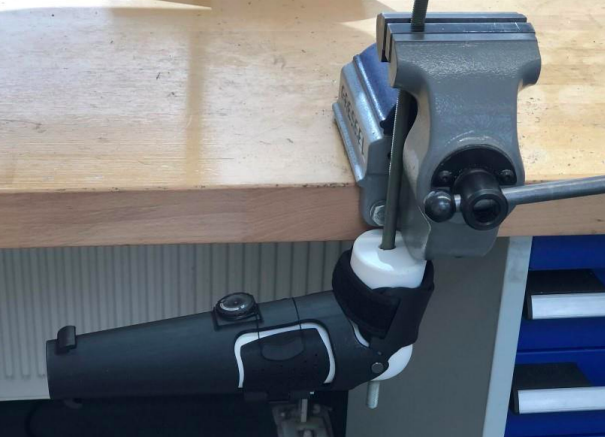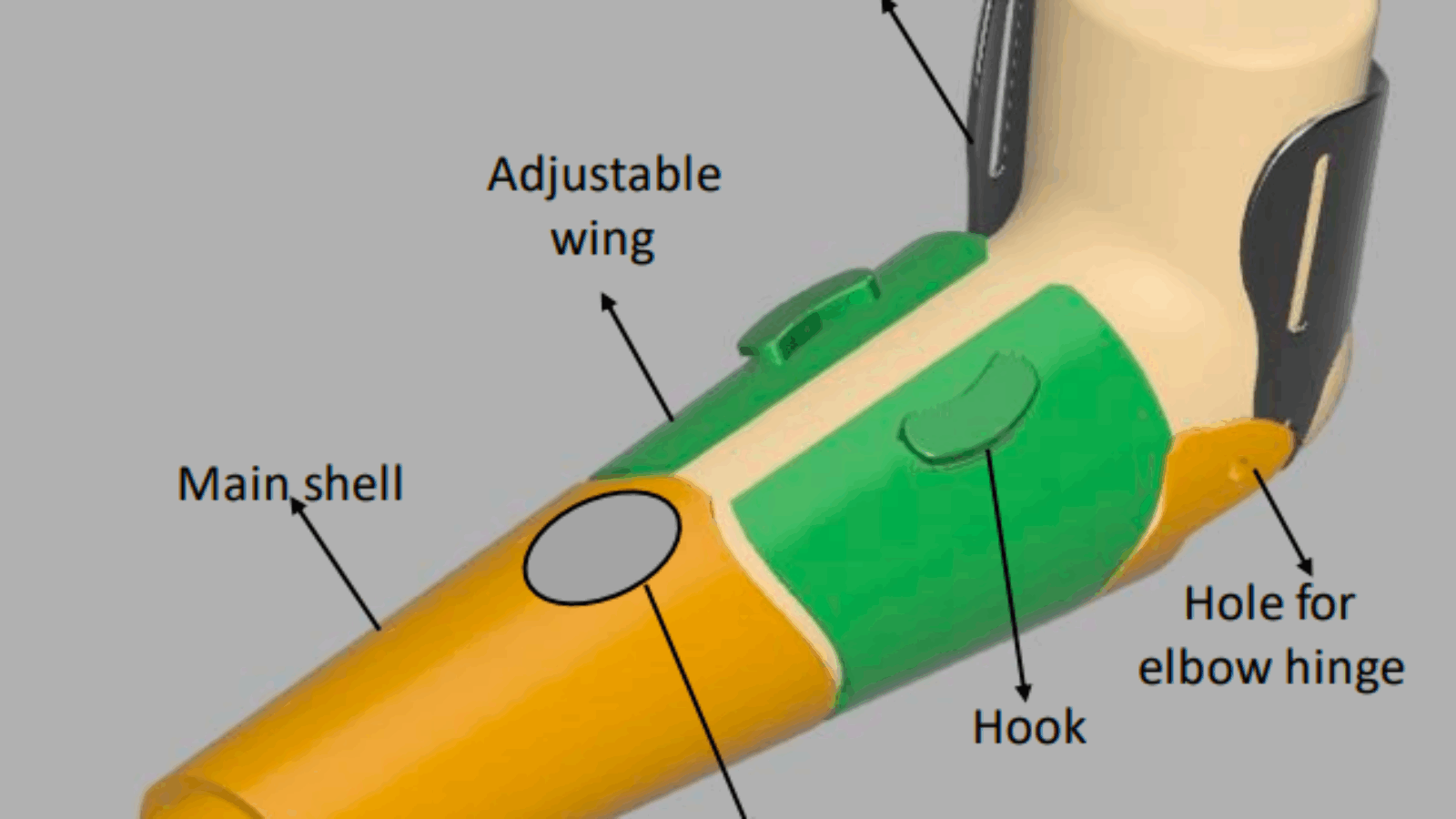A mechanical engineering student at TU Delft has designed a prosthetic upper-limb socket that can be 3D printed using an everyday FDM system for only €30.
Nicknamed ‘V3D,’ the transradial device features a volume-adjustable closure system, allowing users to easily attach artificial limbs before moving them with a high range of flexion and full elbow extension. Taking just four hours to print, the versatile socket is designed to address the needs of those living in remote areas, where access to 3D scanners and customized prosthetics is likely to be limited.

Overlooked upper-limb amputees
Each year, between 6,000 to 10,000 U.S. citizens undergo upper-limb amputations, in a procedure that sees them lose part of their forearm, and get fitted with a socket for a prosthetic to help restore their bodily functions. These sockets are vital to enabling the secure attachment of certain artificial limbs, and when they’re poorly-fitted, they can cause wearers to suffer from blistering to nearby tissues.
At present, many limb sockets are manufactured via a time-intensive plaster molding process that can take up to five weeks, and if patients change in weight or size, they have to endure this wait all over again. Using 3D printing, on the other hand, it’s now possible to rapidly turn anatomical 3D scans into personalized prosthetics, but this approach has largely been limited to creating lower-limb sockets thus far.
In order to bring the benefits of additive manufacturing to upper-limb amputees, Delft masters student Israa Kamal therefore set about designing a novel prosthetic socket, that can not only be fabricated and fitted on-demand, but be adjusted to meet the needs of individual patients and allow them to fully-extend their elbow without restriction.

On-demand artificial limb sockets
Initially, Kamal came up with five socket concepts, each featuring different mechanisms and levels of breathability, before combining the best bits of two fastening models to create a single optimized design. The Delft engineer’s final layout consisted of a main shell, adjustable wings and an upper attachment, which was designed to be connected to prosthetics using revolute joints at the elbow.
In theory, the concept allows users to freely adjust the socket without interfering with the wrist unit, while the end of the device can be customized to fit the wrists of individual wearers. Once settled on her final design, Kamal leveraged an Ultimaker S5 3D printer and PLA material to create a €30 prototype, and if produced en-masse she says that they could be made even more cheaply in future.
Compared to conventional sockets which weigh around 240g, the V3D proved to be considerably lighter at 170g, and during axial loading, bending and impact tests, the device was capable of withstanding 10 kg of load, induced stresses of up to 50N, and drops from up to 2.4 meters in height without exhibiting any visible damage.

Having validated her novel design, Kamal enlisted the help of five volunteers, who due to COVID-19 restrictions were able-bodied, but still proved able to evaluate the device’s comfort and functionality. Ultimately, the socket could be adapted to the different-sized limbs of each participant, but while they were able to fully-extend their elbows, their level of flexion freedom varied depending on the device’s fit.
Manufacturing on Demand
Based on her early results, Kamal concluded that fitting a functional socket is dependent on the dimensions of a patients’ residual limb at the point in which the elbow is flexed to 90°. To accommodate this, the student engineer drew up a ‘size guide’ for future socket fittings, before adding that further iterations of her design could include an elbow ball joint, to provide users with a higher flexion range.
Following the V3D’s initial success, its design now been passed onto Radboud University Medical Center (RUMC), where the 3D printed prosthetics will be developed for treating amputees in the Netherlands and Sierra Leone. “The socket has proved that it can be fitted using a caliper in case 3D scanners are not available,” concluded Kamal in her research.
“That advantage makes producing the V3D feasible in communities that do not have access to 3D scanners,” she added. “Furthermore, the socket can be parameterized such that users with similar geometry and comparable sizes of residual limbs can fit the same socket, which would make the fabrication process less labor-intensive and less time-consuming, as it was aimed for.”
3D printing prosthetics at pace
While AM is often deployed to produce prosthetics, it’s usually used to create the limbs themselves rather than their connecting sockets. In the past, wearables specialist UNYQ has somewhat bucked this trend with its 3D printed leg socket, although unlike Kamal’s work, the device was really designed to treat lower rather than upper-limb amputees.
Elsewhere, additive manufacturing is increasingly enabling the production of prosthetics on a larger scale, and scientists from the Israel Institute of Technology have managed to create a limb 3D printing production line. By combining advanced imaging with scanning and printing technologies, the team there is now able to produce lifelike extremities at the click of a button.
In a similar vein, prosthetics manufacturer Partial Hand Solutions (PHS) has revealed that it’s currently using Formlabs’ Form 1 3D printer to fabricate its pediatric M-Finger and Elbow implants. Switching from injection molding to SLS additive manufacturing has enabled the firm to reduce its lead times from weeks down to just a couple of days.
For a deeper-dive into additive manufacturing, you can now subscribe to our Youtube channel, featuring discussion, de-briefs and shots of 3D printing in-action.
* This article is reprinted from 3D Printing Industry. If you are involved in infringement, please contact us to delete it.
Author: Paul Hanaphy


Leave A Comment